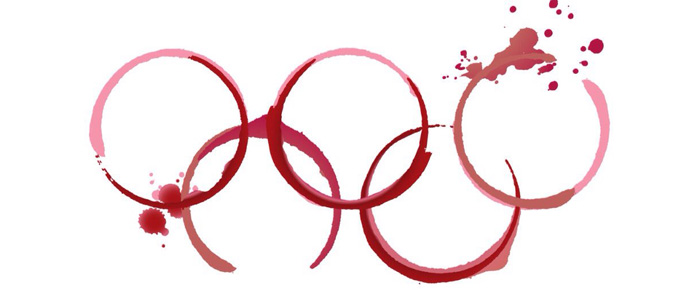
By Rick Riozza
Whether we’re here in the desert, out on our annual wine country trip, or actually down live in “Rio Dej”, we are no doubt joining in on all of the fun and fanfare of the Rio 2016 Olympic Games. With the broadest of brushes, let’s have some summer fun and snoop out our favorite Olympic-themed wines to quaff & watch the finals.
Of course being vino lovers, we can absolutely pivot and cheer-on any bona fide beverage that fits the bill. Here, of course, there’s no is getting by the national drink of Brazil and the most ordered cocktail in town: the Caipirinha [KYE-peer-EEN-nya], a lime Mojito is a general sense. Sweet, tart and strong, the Caipirinha is mixed with the Brazilian spirit cachaça [cah-SHAS-sa]
It’s a distilled spirit made from sugar cane, as opposed to Caribbean rum, which is made from molasses. Unaged, its taste is somewhere between rum and tequila; aged, it takes on a complex flavor than can vary from woodsy to vanilla-like to floral. Avuà Amburana—a cachaça aged in barrels made from amburana wood—adds a warm depth to the fruity Caipirinha.
Now what do we know about Brazilian wine. I remember back in the 80s, I went to a wine tasting party in Laguna Beach that was hosted by a master-craftsman who also owned a plot of land in the Sonoma hills growing pinot noir. Wishing to kind-of impress him, I brought an out-of-the-ordinary Brazilian Cab Sauv to the party.
If it were anyone else, I’m sure the guy would have thought that wine was found in some discount bin. But since I had just gone to Christie’s Auction House on behalf of a client to bid on the Thomas Jefferson 1789 Lafite (Forbes winning the bid at $165,000), apparently I had gained some wine gravitas, and my pick for the party was at least considered. Actually I had just purchased the Brazilian wine at Trader Joe’s for around $12—back then, a fairly pricey wine for the store.
The Cabernet Sauvignon was very good—velvety with dried fruit flavors and leather notes; a brickish-red wine that apparently aged quickly in the bottle. I think it went over well, but I’m sure some party people still thought I’d found it in some discount wine bin at Big Lots.
One could say that the Brazilian wine trade has been working undercover. It’s been Argentina and Chile who claim the limelight to some very delicious wine. But Brazil is South America’s third largest wine producer; however, they’re not big wine exporters, which is why we don’t see much of it anywhere. I haven’t seen a Brazilian wine on the shelves—even over at Trader Joe’s, in a long time.
But if you can find one, bringing a Brazilian wine to the party now is a very sexy move! You know—the Brazilians, like the world, are all in on the game of wine. And they seem to drink most of the stuff they produce—which is a lot! The French company Moët & Chandon showed up in the early 1970s with most of Europe following, planting all of our favorite varietals. The trendiest wine region in Brazil right now is way south near the border to Uruguay.
For reds, look first to the Merlots. That grape ripens early and can be harvested before the Brazilian rains of March (Southern Hemisphere switches seasons). How cool is it when we’re sipping on a Brazilian Merlot while listening to the stylish and creative chord changes in the tune Águas de Março (the Rivers of March) by “Tom” Jobim.
Along with Merlot and Cabernet Sauvignon, Brazilian vintners are spending a good deal of time with the Tannat [tah-NOT] grape. In neighboring Uruguay, Tannat seems to be the national craze and they are producing some tasty stuff.
Like the Malbec in Argentina, these grapes were brought over from the southwest of France. In the days of old, a Tannat/Malbec wine was known as “le vin noir”—“black wine”, due to its very dark color (which translates to a very nutritious/if not a “healthy” wine: Google it—physicians are recommending it to their heart patients).
I’m thinking that Brazil will also achieve great things with Tannat. Believe me—when that catches on, we’ll start to find more Brazilian wine at our markets.
Just in case someone’s offering to pick up some Brazilian wine for your Olympic-viewing party, some very good labels to ask for are Casa Valduga Leopoldina, both their Chardonnay and Merlot are excellent; the Vinacola Guaspari Syrah is stellar—expressive and highly aromatic with multiple layers of blueberry, mature blackberry, bacon, black pepper, smoke and graphite; and, Vinacola Salton, Intenso Brut, is a non-vintage sparkler that is fresh with pear, green apple, lush white jasmine, orange, and lemon zest. A fabulous fizz that’s vibrant with a refreshing finish—goes with everything you’re serving!
Italian wines have always been a popular import quaff at restaurants and cafés in and around Rio. Pizzato is a Brazilian wine producer with obvious Italian roots. Assuming we’ll locate a bottle, the Pizzato Concentus is a blend of 45% Merlot, 35% Tannat & 20% Cabernet Sauvignon. It lets you know that Brazil can produce excellent reds: Deep, concentrated with red berry nose, Mocha, spices, cedar, and dried plum on the palate. Very smooth but with nice tannins. Decant—it opens up to show real balance, suppleness and touch of caramel on a long, fresh finish.
Go for the gold with this Brazilian red that is superlative with steaks served in its own wine sauce.
Saúde! para os Jogos Olímpicos!









































